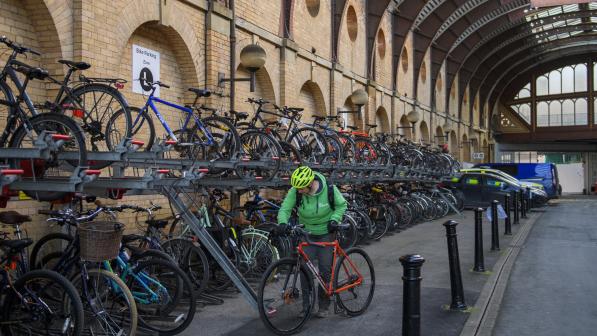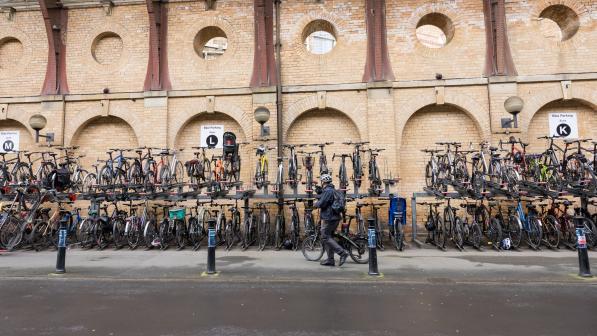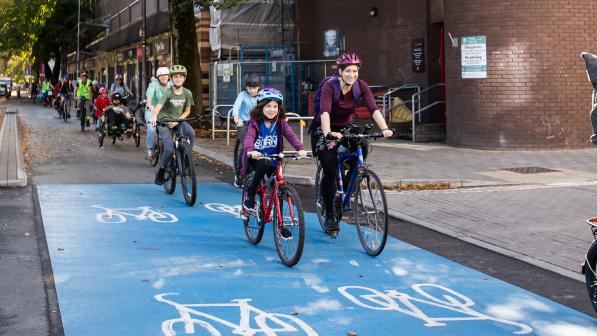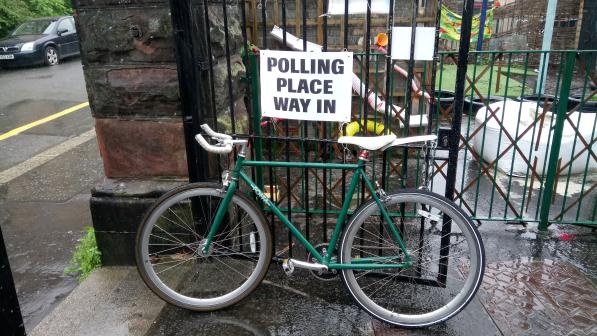Building better connections by bike

On a sunny day in late September, I joined Cardiff Cycle City for a celebration ride along Cycleway 1, a route that connects the city centre to the University Hospital of Wales in the Heath, passing through residential streets and Cardiff University as it does so.
Cardiff Cycle City organised the ride to raise awareness of this high-quality segregated route, the most complete in the planned network, and to demonstrate that when good cycling infrastructure is built and promoted, it will be used by people of all ages and abilities.
And it worked! Mums and children, people on trikes and tandems, electric bike riders and many more came together to cycle confidently from the heart of the city to the Heath.

A long time coming
I lived in Cardiff until recently, and there were times I wondered if Cycleway 1 would ever become a truly useful route. I remember when the first significant section opened along Senghenydd Road past the Sherman Theatre. We marked its completion with a celebratory, albeit very short, ride, some six years ago.
For years, Cardiff’s cycling infrastructure has felt like a patchwork of good intentions: routes that begin and end abruptly, disconnected from each other and the places people want to go.
Cycling networks only become transformative when they connect. When they allow people to get from home to work, to school, to the shops or the park without facing the barriers that a disjointed collection of cycle routes or unfriendly roads presents.
The seemingly slow rate at which active travel networks progress makes it more difficult to ‘sell’ the need for investment. People see the unfinished stretches which they know have cost a significant amount of money – though cheap in comparison to other transport investment – and question what the point is when relatively few people seem to be using them.
Politicians often hear these negative messages rather than from those who think that creating towns and cities where people have real choices as to how they travel is essential.
We need the voices of those campaigning for continued, increased levels of investment to enable sustained change at pace to be heard. Let your MS know that you want investment to continue.
Many questioned why the path along Senghenydd Road was the first section of Cycleway 1 to be built as the road was relatively quiet. But it was one of the easier sections, one that didn’t require too much rethinking of road space or expenditure of political capital.
Political will, public demand and funding
Much of Cycleway 1 is in the Cathays ward, represented by Sarah Merry, Deputy Leader of Cardiff Council and in her own words a less-than-confident cyclist.
Some months ago, Laura from Cardiff Cycle City and I went on a cycle safari of the ward with Sarah and talked about the challenges faced in joining up the network as we cycled around, identifying some of the weak spots on the route.

The cycle route passes by parts of the city where car parking space will always be regarded as insufficient – streets of terraced houses simply don’t have space for the numbers of cars people would like to be able to park on them.
Local councillors have to deal with objections and make the case for the routes. Their job is made easier if they hear from those of us who want to be able to get about safely by bike, as it’s often those who object that are most vocal.
Our local councillors play a crucial part in ensuring that funds from Welsh government are spent in ways that will best benefit those who will cycle if the environment is right.
Our current campaign ‘My ride. Our right’ is for Sarah and all the other women like her who will miss out on cycling without significant investment in high-quality segregated routes.
Our research shows that women make half as many trips by bike as men and are more likely to be put off cycling by a fear of busy traffic. We need routes such as Cycleway 1 that feel safe and get people where they need to go.
Critics often argue that building cycling infrastructure costs too much. But what is the real value of enabling more people to travel safely by bike?
When we build safe cycle routes children can walk and cycle to school independently, equipping them with skills they need as they grow. Parents can ride safely with their kids on quieter streets with cleaner air. High streets that are more accessible for those arriving by bike become more vibrant and people of all ages and abilities can move more freely.

Who couldn’t agree that this is a worthwhile return on investment? One that is urgently needed if we are to enable everyone to lead happier, healthier, greener lives. The benefits are profound, and they are good for everyone whether they ride a bike or not.
Over the last few years Cardiff’s ambition has been rewarded with Welsh government funding, and we are now beginning to see the results.
Providing sustained funding for cycling infrastructure is essential but cycle paths alone are not enough. It takes political will at a local as well as national level and a lot of effort from of wide range of people.
In recent years we have seen that in Cardiff, with councillors across the city supporting investment in walking and cycling and making the case on the doorstep.
There are some dedicated staff working in active travel within the council, people who ride bikes themselves, who understand what’s needed on the ground, and who’ve developed innovative projects to enable more people to cycle.
Projects inclucing adult cycle training, fleets of bikes made available to schools and, after much lobbying from Cardiff Cycle City, we should finally see on-street bike hangars.
The part that Cardiff Cycle City and others lobbying for change have played over the years has been critical – responding to consultations, organising events and rides, engaging with politicians ensuring that they know that cycling matters to the voters of Cardiff.
Change doesn’t come from one single effort or person, it’s a combination of planning, advocacy, political courage and patience.
We’re building a network of campaigners across Wales so that we can better make the case for cycling heard. If you’re interested in joining us, you can find out more about the Cycle Advocacy Network.

Keep on keeping on
If we build it, and we build it well, they will come. But it won’t happen overnight, and it won’t happen if we don’t also invest in breaking down all barriers to cycling: access to affordable bikes, cycle training, safe storage and signage are all things that need to happen too.
Progress on the good-quality infrastructure we’re starting to see in Cardiff has been made possible by sustained, ring-fenced funding for active travel provided by Welsh government.
With the Senedd election next May and changes to the way in which funding for active travel is made all this may change, and we’re determined to do all that we can to ensure that every local authority in Wales can continue to develop networks that give people real choices about how they travel.
Too many people are locked into driving for journeys because there’s no safe space to cycle or no reliable public transport for them to use. This must change if we are to enable everyone to lead happier, heathier and greener lives.



